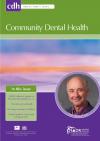Community Dental Health

- Cover Date:
- June 2016
- Print ISSN:
- 0265 539X
- Vol:
- 33
- Issue:
- 2
Child oral health in migrant families: A cross-sectional study of caries in 1-4 year old children from migrant backgrounds residing in Melbourne, Australia
Early Childhood Caries (ECC) is the most common, preventable disease of childhood. It can affect children’s health and wellbeing and children from migrant families may be at greater risk of developing ECC. Objective: To describe ECC in children from migrant families, and explore possible influences. Basic research design: Cross-sectional analysis of caries data collected as baseline data for an oral health promotion study. Participants: The analysis sample included 630 1-4 year-old children clustered within 481 Iraqi, Lebanese and Pakistani families in Melbourne, Australia. Method: Child participants received a community-based visual dental examination. Parents completed a self-administered questionnaire on demographics, ethnicity, and oral health knowledge, behaviour and attitudes. Main outcome measure:
Child caries experience. Bivariate associations between oral health behaviours and ethnicity were tested for signiï¬cance using chi-square. Multivariate logistic regression analyses were performed to identify associations with ECC, adjusting for demographic variables and accounting for clustering by family.
Key words: oral health, dental caries, dental decay, child, pre-school, migrants, Australia
doi:10.1922/CDH_3698Gibbs07
- Article Price
- £15.00
- Institution Article Price
- £
- Page Start
- 100
- Page End
- 106
- Authors
- L. Gibbs, A.M. de Silva, B. Christian, L. Gold, M. Gussy, L. Moore, H. Calache, D. Young, E. Riggs, M. Tadic, R. Watt, I. Gondal, E. Waters
Articles from this issue
- Title
- Pg. Start
- Pg. End
- Child oral health in migrant families: A cross-sectional study of caries in 1-4 year old children from migrant backgrounds residing in Melbourne, Australia
- 100
- 106
- Feasibility, utility and impact of a national dental epidemiological survey of three-year-old children in England 2013
- 116
- 120
- A bi-level intervention to improve oral hygiene of older and disabled adults in low-income housing: results of a pilot study
- 127
- 132
- Caries and costs: an evaluation of a school-based fluoride varnish programme for adolescents in a Swedish region
- 138
- 144
- Examiner reliability in fluorosis scoring: a comparison of photographic and clinical methods
- 145
- 150
- Do ‘poor areas’ get the services they deserve? The role of dental services in structural inequalities in oral health
- 164
- 167
